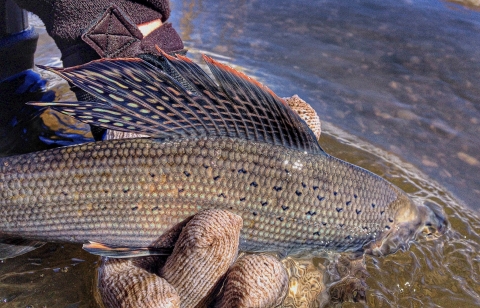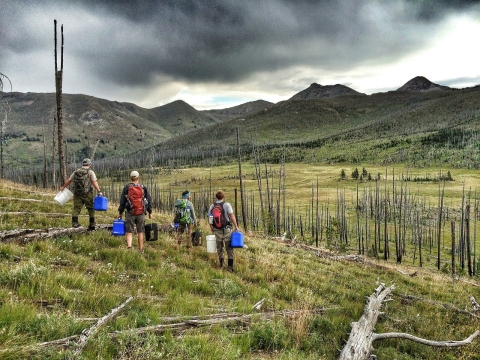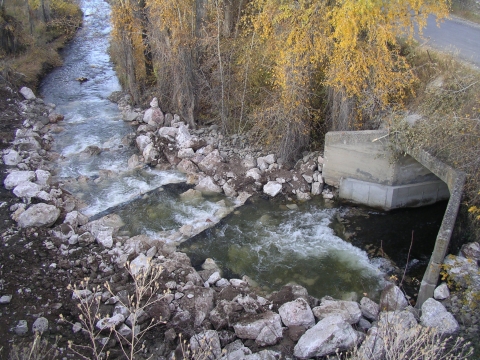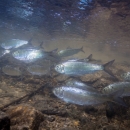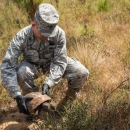What We Do
Conserving imperiled fish and aquatic species and wildlife species – i.e. those in serious decline or listed under the Endangered Species Act – by planning, coordinating, implementing, and evaluating activities such as habitat restoration and captive propagation. Currently the Montana Fish and Wildlife Conservation Office is focused on three species (Arctic Grayling, Bull Trout, Yellowstone Cutthroat Trout). Activities include:
- Native American Tribal Assistance - Fulfilling trust responsibilities to Native American tribal governments on reservations and in ceded territories. This includes managing fish and wildlife resources, restoring native species, recovering threatened and endangered species, and restoring habitats etc.
- Federal Lands Assistance - Assisting Federal land managers (e.g. Department of Defense) in fish and wildlife management on Federal lands and assisting National Wildlife Refuges in planning, managing, and restoring fisheries and aquatic resources.
- Fish Passage - Restoring fish passage fish passage
Fish passage is the ability of fish or other aquatic species to move freely throughout their life to find food, reproduce, and complete their natural migration cycles. Millions of barriers to fish passage across the country are fragmenting habitat and leading to species declines. The U.S. Fish and Wildlife Service's National Fish Passage Program is working to reconnect watersheds to benefit both wildlife and people.
Learn more about fish passage in streams where dams or other structures have obstructed access to habitats. This includes restoring flows. - Interjurisdictional Fisheries Assistance - Providing services to regional and interstate, fishery commissions and other organizations for Service trust species.
- Aquatic Nuisance Species - Increasing public awareness of invasive species invasive species
An invasive species is any plant or animal that has spread or been introduced into a new area where they are, or could, cause harm to the environment, economy, or human, animal, or plant health. Their unwelcome presence can destroy ecosystems and cost millions of dollars.
Learn more about invasive species ; and providing technical assistance to control and prevent invasive species.
Management and Conservation
Montana Fish and Wildlife Conservation Office biologists are actively involved in restoring spawning runs of the adfluvial form of Arctic Grayling to historically used streams within Red Rock Lakes NWR and to a nearby lake they formerly inhabited. Through the use of remote site incubators, we have successfully returned 130,000 grayling fry to Elk Springs Creek and 150,000 fry to Elk Lake.
In 1997, the Service’s Northern Rockies Fish and Wildlife Conservation Office began working cooperatively with the Blackfeet Tribe, Glacier National Park, and the U.S. Bureau of Reclamation (Reclamation) to focus on gathering important information on the status and biology of the St. Mary River population of Bull Trout. Specifically, Reclamation is evaluating a new St. Mary River irrigation diversion and canal headworks facility that will incorporate fish-friendly structures and provide protection from entrainment.
In 1988, the Montana Fish and Wildlife Conservation Office began assisting the Crow Tribe with fisheries management on their lands thinking that all the native Yellowstone Cutthroat Trout were extirpated or hybridized with non-native Rainbow Trout. However, our sampling collected Yellowstone Cutthroat Trout from Rotten Grass Creek in the first year, which phenotypically appeared pure. The Crow Tribe and Montana Fish and Wildlife Conservation Office staff started stocking selected streams with hatchery-reared Yellowstone Cutthroat Trout in 2011. To date, seven separate stream sections have been stocked helping to ensure survival of this native species within Crow tribal waters.
Our Services
Currently there are approximately six million acres of reservation land within Montana. Of this, approximately 5.4 million acres are trust acres over which the tribes have full jurisdiction. We provide technical assistance to Tribal governments to help them make informed decisions regarding their management of Tribal natural fish and wildlife resources. We strive to ensure that Tribal governments acquire and maintain the necessary data and expertise to professionally manage these resources. We help accomplish this through collaborative efforts including data collection and interpretation, natural resource personnel training, and facilitating Tribal planning efforts.
The Sikes Act recognizes the importance and value of the nearly 30 million acres of military lands to natural resources. The Sikes Act requires the Department of Defense to develop and implement Integrated Natural Resources Management Plans (INRMPs) for military installations. Our office works closely with Malmstrom Air Force Base, Montana with INRMP development and implementation. Additionally, we provide technical assistance to this base for management of recreational fishing opportunities.

